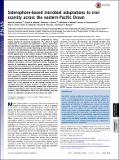Siderophore-based microbial adaptations to iron scarcity across the eastern Pacific Ocean
Author(s)
Mende, Daniel R.; McIlvin, Matthew R.; Saito, Mak A.; Sedwick, Peter N.; DeLong, Edward F.; Repeta, Daniel J.; Boiteau, Rene Maurice; Hawco, Nicholas James; Fitzsimmons, Jessica Nicole; ... Show more Show less
DownloadBoiteau-2016-Siderophore-based microbial adapt.pdf (2.273Mb)
PUBLISHER_POLICY
Publisher Policy
Article is made available in accordance with the publisher's policy and may be subject to US copyright law. Please refer to the publisher's site for terms of use.
Terms of use
Metadata
Show full item recordAbstract
Nearly all iron dissolved in the ocean is complexed by strong organic ligands of unknown composition. The effect of ligand composition on microbial iron acquisition is poorly understood, but amendment experiments using model ligands show they can facilitate or impede iron uptake depending on their identity. Here we show that siderophores, organic compounds synthesized by microbes to facilitate iron uptake, are a dynamic component of the marine ligand pool in the eastern tropical Pacific Ocean. Siderophore concentrations in iron-deficient waters averaged 9 pM, up to fivefold higher than in iron-rich coastal and nutrient-depleted oligotrophic waters, and were dominated by amphibactins, amphiphilic siderophores with cell membrane affinity. Phylogenetic analysis of amphibactin biosynthetic genes suggests that the ability to produce amphibactins has transferred horizontally across multiple Gammaproteobacteria, potentially driven by pressures to compete for iron. In coastal and oligotrophic regions of the eastern Pacific Ocean, amphibactins were replaced with lower concentrations (1–2 pM) of hydrophilic ferrioxamine siderophores. Our results suggest that organic ligand composition changes across the surface ocean in response to environmental pressures. Hydrophilic siderophores are predominantly found across regions of the ocean where iron is not expected to be the limiting nutrient for the microbial community at large. However, in regions with intense competition for iron, some microbes optimize iron acquisition by producing siderophores that minimize diffusive losses to the environment. These siderophores affect iron bioavailability and thus may be an important component of the marine iron cycle.
Date issued
2016-12Department
Massachusetts Institute of Technology. Department of Earth, Atmospheric, and Planetary SciencesJournal
Proceedings of the National Academy of Sciences
Publisher
National Academy of Sciences (U.S.)
Citation
Boiteau, Rene M. et al. “Siderophore-Based Microbial Adaptations to Iron Scarcity Across the Eastern Pacific Ocean.” Proceedings of the National Academy of Sciences 113, 50 (December 2016): 14237–14242 © 2016 National Academy of Sciences
Version: Final published version
ISSN
0027-8424
1091-6490